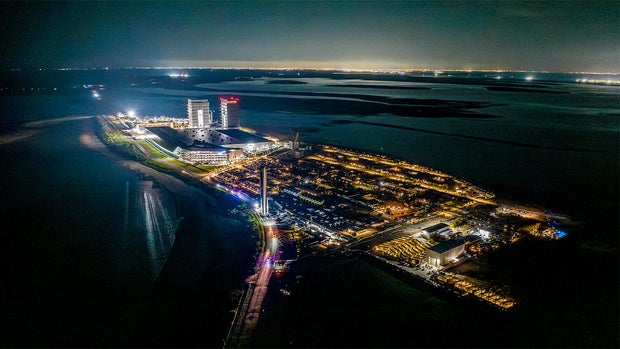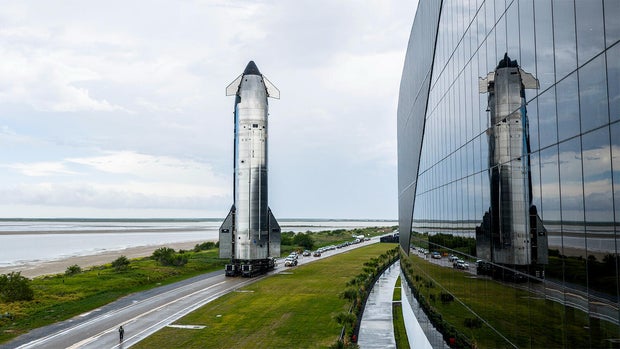After three catastrophic in-flight failures in a row, SpaceX readied an enormous Tremendous Heavy-Starship rocket for launch Sunday night from the Texas Gulf Coast to place a wide range of upgrades to the check and to intentionally stress the car to study extra about its capabilities.
Take a look at flight No. 10 was anticipated to get underway at 7:30 p.m. ET from SpaceX’s Starbase flight and manufacturing facility and the workforce was within the strategy of pumping liquid oxygen and methane gasoline into the 40-story-tall rocket when the corporate introduced a scrub.
“Standing down from right now’s tenth flight of Starship to permit time to troubleshoot a difficulty with floor methods,” the corporate mentioned on X. SpaceX later announced that another hour-long launch window would open at 7:30 p.m. EDT Monday.
Stephen Clark/Ars Technica
The flight plan had referred to as for the 30-foot large, 230-foot tall Tremendous Heavy booster, producing greater than 16 million kilos of thrust, to propel the Starship out of the dense decrease ambiance earlier than it will fall away, flip round and head again towards the coast.
Throughout three of the 9 earlier check flights, the booster flew itself all the best way again to its launch pad the place large mechanical arms on the service gantry plucked the descending rocket out of midair. This time round, due to the deliberate checks, the Tremendous Heavy was anticipated to descend to splashdown within the Gulf, however it by no means took off.
SpaceX beforehand mentioned the first targets for the booster check was targeted on its touchdown burn. One of many three heart engines used for the ultimate section of touchdown was going to be “deliberately disabled to collect knowledge on the power for a backup engine from the center ring to finish a touchdown burn,” the corporate mentioned on its web site.
The booster was then going to make use of two engines towards the top of the descent and hover briefly earlier than dropping to the Gulf.
The 160-foot-tall Starship, in the meantime, powered by six Raptor engines of its personal, would have headed for a suborbital trajectory carrying it midway world wide earlier than a belly-first reentry, a flip again to vertical and a rocket-powered descent to splashdown within the Indian Ocean.
Together with deploying eight Starlink simulator satellites, the Starship’s flight pc had deliberate to aim a wide range of different checks, together with an in-space engine restart, to confirm the efficiency of quite a few upgrades applied within the wake of the newest check flight failures.
SpaceX
Working the bugs out of the enormous launcher is vital to SpaceX and founder Elon Musk, who designed the ultra-heavy-lift rocket to launch 1000’s of next-generation Starlinks and different satellites in Earth’s orbit and to someday carry settlers and gear to Mars.
The rocket is also vital to NASA, which is paying SpaceX greater than $3 billion to develop a modified model of the Starship higher stage to hold Artemis astronauts to the floor of the moon in 2027.
However that flight would require 10 to twenty Tremendous Heavy-Starship flights simply to refuel the “Human Touchdown System,” or HLS, lander earlier than it may well head to the moon. Transferring 1000’s of gallons of super-cold liquid nitrogen and oxygen in house has by no means been tried.
And it’s nonetheless not identified how SpaceX plans to regulate propellant temperatures to attenuate the quantity that may naturally heat up and switch right into a gasoline, which have to be vented overboard. SpaceX has supplied no particulars. Musk promised pre-launch replace Sunday on the corporate’s plans going ahead, however the speak was additionally canceled with no rationalization.
Given the variety of flights that have to be efficiently executed to reveal the reliability NASA will anticipate, the 2027 goal date for the Artemis 3 moon touchdown is taken into account unrealistic, if not unattainable to fulfill, by many aerospace observers.
China plans to launch its personal astronauts on the moon by 2030. It’s unclear at this level whether or not NASA and SpaceX will get again to the moon utilizing the Starship lander earlier than the Chinese language plant their very own flag on the lunar floor.
Given the sheer measurement and energy of the Tremendous Heavy-Starship — it has greater than twice the thrust of NASA’s present Area Launch System, or SLS, moon rocket — technical issues throughout growth weren’t surprising.
SpaceX
However given the quick time between now and NASA’s first deliberate Artemis moon touchdown, the issues have clearly set this system again and forged doubt on the general mission structure, particularly the requirement for 10 to twenty problem-free flights briefly order simply to gasoline the lander for its flight to the moon.
The primary three check flights of the Tremendous Heavy booster and Starship higher stage in 2023 and 2024 led to catastrophic failures with each levels destroyed, both whereas nonetheless connected to one another or after separation.
The fourth flight in June 2024 was typically profitable with the Tremendous Heavy flying itself again to a managed splashdown within the Gulf whereas the Starship adopted the deliberate sub-orbital trajectory to splashdown within the Indian Ocean. The ship’s fins have been broken by reentry heating, however in any other case labored as required.
The fifth flight in October 2024 was highlighted by a profitable Tremendous Heavy return to the launch pad gantry the place large mechanical arms snagged the rocket in mid air. The Starship, in the meantime, managed a second managed splashdown within the Indian Ocean though it once more suffered fin harm throughout reentry.
In the course of the sixth built-in flight check in November 2024, the Tremendous Heavy tried one other return to the launch web site however it was diverted to a Gulf splashdown due to launch harm to vital sensors within the pad’s seize mechanism. The Starship once more flew itself to a managed Indian Ocean splashdown with minimal flap harm.
However the subsequent three flights, in January, March and Might of this yr, ended with catastrophic failures. Two Tremendous Heavy boosters efficiently returned to the launch web site, however the newest broke up over the Gulf whereas testing a excessive angle-of-attack entry.
All three Starships have been destroyed after catastrophic malfunctions, together with two propellant leaks, an on-board hearth and a number of engine failures.
Along with the flight document, one other Starship was destroyed on the bottom when a high-pressure nitrogen tank exploded throughout an engine check firing on the Starbase launch web site.



